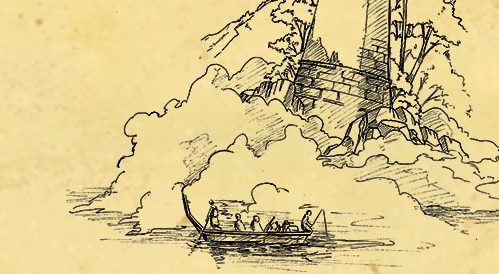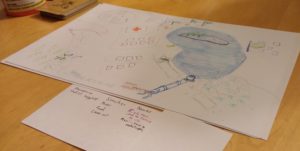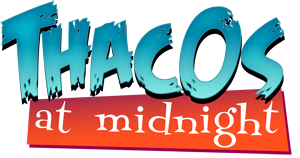
For a long time, we were at war with The Jackals. But now, we’ve driven them off, and we have this – a year of relative peace.
The Quiet Year was one of the games that I picked up on our JiffyCon road trip. It’s a game I’ve wanted for a long time but I never got around to buying it for various reasons. Avery Alder is a Canadian game developer, but finding her games in her own country is sometimes difficult.
Alder’s games have grabbed my attention in the past because they go to emotional and setting spaces other games often don’t consider. Monsterhearts is one of if not the most emotionally fraught Powered by the Apocalypse game on the market. Dream Askew takes your standard post apocalyptic roleplaying setting and pushes themes like queer identity and classism into the foreground. Ribbon Drive is a fascinating exploration on using music as game mechanic rather than just a tool for atmosphere. I was excited for The Quiet Year and its focus on the post apocalypse and community building.
What I ended up playing was a game that addressed community organization and management in a way that I didn’t expect; through a focused lens of disconnection. The experience was a bit jarring to other players at the table and left me with mixed feeling.
Alder’s describes The Quiet Year as a “Map Game”. It’s by far more of a map-based or a broadly focused storytelling game than a roleplaying game. The closest counterpart on the market is Microscope, although The Quiet Year encourages players to remove themselves from playing characters even more than Microscope. The players collectively represent abstract parts of a community struggling to survive. Changes in the setting and story are driven by players adding things to a shared map and drawing random events from a card deck.
The world doesn’t exist in a fixed status quo. When the game opens, the community has driven off a force known as The Jackals. The game will end the Frost Shepherds arrive. Who and what the Jackals and the Frost Shepherds are is up to the players to define. The community has about a year to clean up the mess that the Jackals caused, try to bring their resources into surplus again and prepare for the coming winter.
The passing of time is marked by the card deck; each card represents the events of one week. The physical copy of the game comes with a deck of cards. The PDF version has an Oracle that allows players to use a standard 52 playing card deck and then reference what would be on that particular card in the official deck. We played using the official deck, which is designed to aesthetically match the post apocalypse setting. All of the colours are muted and different seasons are colour coded.
A turn involves the active player pulling a card from the deck, reading out the text and then performing an action: either discovering something new on the map, holding a discussion or starting a project.
The level of interaction between players is one of the game’s biggest gimmicks and the main source of my mixed feelings. Players refrain from unnecessary discussion and cannot speak out against another’s actions. They can take a Contempt Token to “express” their frustrations, but otherwise can’t openly discuss them.
This lack of direct emotional content is in stark contrast with many of Alder’s other games, which wear their hearts on their sleeves. The emotional design choice is intentional; the game is meant to reflect the disconnect that exists between people on a community level. This disconnect leads to disagreements between different parts of communities, which in turn results in indecision that stalls progress. The game spotlights this, but it comes at the expense of players looking for a more emotional gaming experience.
If your players are more emotionally focused but are interested in a game about post-apocalyptic communities, Dream Askew is probably a safer bet. If your players are open-minded and flexible, there may be value in playing both games with the same group and seeing what collective discussion follows. Both games touch on the same themes, but have very different focuses and intended outcomes.
The Quiet Year also runs a little bit on the long side. The Frost Shepherds came mercifully early in our Winter. The rulebook mentions special rules for a shorter game called A Fleeting Year. I recommend that rules variant for people trying out the game for the first time. It will allow your game to experience all of the seasons faster and have much tighter pacing.
I walked away from the game feeling the same about the Quiet Year as I do a lot of Alder’s work: It took me to an interesting and challenging game space. I enjoyed the experience on a personal level. Where I struggled was the facilitator level. Some of my players were turned off of the emotional disconnected nature of the game and had certain expectations of the type of game that Alder would write. In this context, I feel the Quiet Year is a great example of Alder’s depth as a game creator. However, given that she is more well-known for games with more surface-level emotions, it may be wise to have a discussion about the emotional content with players before the game so that everyone is on the same page.
The physical copy of the game has been recently reprinted and comes in two different versions. The standard version has a small rule book and the card deck. The deluxe version adds in d6s for project countdown timers, skull beads for contempt tokens and a burlap sack to store the game all together. The PDF version is just a pdf of the rulebook. You provide your own playing cards.
Alder’s website has some digital content for the game. The most notable is a small free supplement called Charted Areas, which features three sample community maps complete with suggested Starting Resources. The content in Charted Areas is intended for quick start or convention play. It’s worth checking out for the curious as the community maps reference back to the ink and pen drawings in the rulebook and give a bit more context to where the places exist in the post-apocalyptic landscape. While the game doesn’t have a fixed setting, I felt this level of detail was delightful.
Final Verdict: The game is a compelling exercise in emotionally disconnected storytelling. Worth trying at least once for the unique experience.
Buy The Quiet Year at Buried Without Ceremony (Print or PDF) or DriveThru RPG (PDF only)

